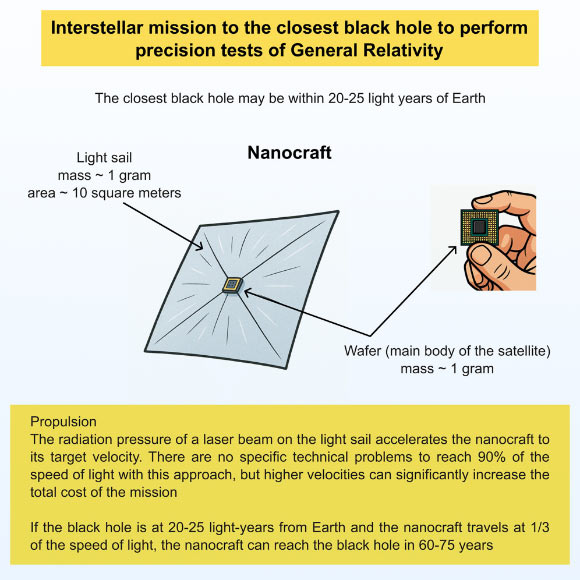In a new paper published in the journal iScience, an astrophysicist from Fudan University discusses the possibility of sending a nanocraft to a black hole at 20-25 light-years from Earth to test the nature of the compact object and fundamental physics in strong gravitational fields.
Black holes are the sources of the strongest gravitational fields that can be found today in the Universe and are ideal laboratories for testing Einstein’s theory of general relativity in the strong field regime. In his article, Professor Bambi shows that the possibility of an interstellar mission to send a small spacecraft to the nearest black hole, although very speculative and extremely challenging, is not completely unrealistic. Image credit: Cosimo Bambi, doi: 10.1016/j.isci.2025.113142.
“We don’t have the technology now. But in 20 or 30 years, we might,” said Professor Cosimo Bambi, an astrophysicist and black hole expert at Fudan University.
“The mission hinges on two key challenges — finding a black hole close enough to target and developing probes capable of withstanding the journey.”
As of now, the closest known black hole to Earth is Gaia BH1, which was discovered in September 2022 and is at a distance of 1,560 light-years.
However, we can expect that there are many unknown black holes closer to Earth.
From simple considerations, we can estimate that the closest black hole to Earth may be at only 20-25 light-years, even if this is just a rough estimate and is affected by large uncertainties.
“Previous knowledge on how stars evolve suggests that there could be a black hole lurking just 20 to 25 light-years from Earth, but finding it won’t be easy,” Professor Bambi said.
“Because black holes don’t emit or reflect light, they are virtually invisible to telescopes.”
“Instead, scientists detect and study them based on how they influence nearby stars or distort light.”
“There have been new techniques to discover black holes. I think it’s reasonable to expect we could find a nearby one within the next decade.”
Once the target is identified, the next hurdle is getting there.
Traditional spacecrafts, powered by chemical fuel, are too clunky and slow to make the journey.
Professor Bambi points to nanocrafts — gram-scale probes consisting of a microchip and light sail — as a possible solution.
Earth-based lasers would blast the sail with photons, accelerating the craft to a third of the speed of light.
“At that pace, the craft could reach a black hole 20 to 25 light-years away in about 70 years,” he said.
“The data it gathers would take another two decades to get back to Earth, making the total mission duration around 80 to 100 years.”
“Once the craft is near the black hole, researchers could run experiments to answer some of the most pressing questions in physics.”
“Does a black hole truly have an event horizon, the boundary beyond which not even light can escape its gravitational pull?”
“Do the rules of physics change near a black hole?”
“Does Einstein’s theory of general relativity hold under the Universe’s most extreme conditions? “
“The lasers alone would cost around one trillion euros today, and the technology to create a nanocraft does not yet exist,” Professor Bambi said.
“But in 30 years, that costs may fall and technology may catch up to these bold ideas.”
“It may sound really crazy, and in a sense closer to science fiction.”
“But people said we’d never detect gravitational waves because they’re too weak. We did — 100 years later.”
“People thought we’d never observe the shadows of black holes. Now, 50 years later, we have images of two.”
_____
Cosimo Bambi. An interstellar mission to test astrophysical black holes. iScience, published online August 7, 2025; doi: 10.1016/j.isci.2025.113142
